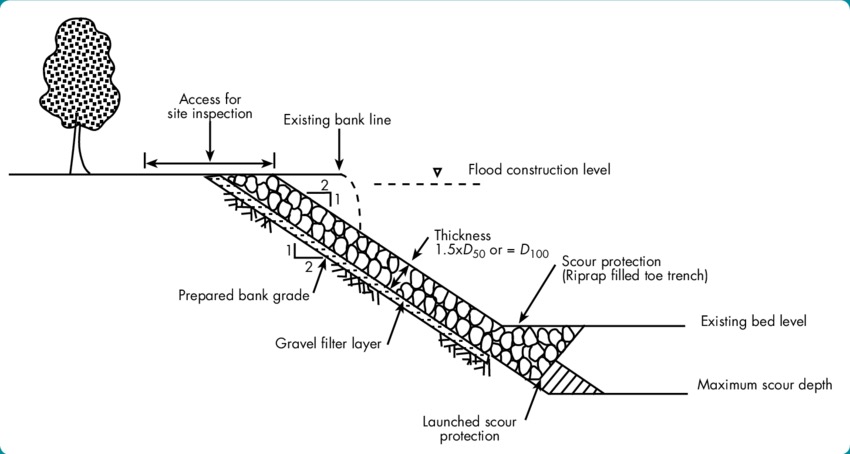Climate Change Adaptation Through Riprap Shorelines
One strategy to mitigate and adapt to the effects of climate change is the use of riprap. This is rock, debris, or other materials used to rebuild shorelines in such a way that they are less affected by the rising sea levels and strengthening storm patterns. The riprap breaks the harsh waves, and stays in place, meaning shoreline erosion is a much slower and more difficult practice. Shoreline erosion has been becoming a bigger issue as the sea levels rise due to climate change, and learning how to work around this is important. Riprap is one strategy that we can use in order to help communities along the coast stay safe and not flood with the coming years. There are pros and cons to this, like any other solution, but since this strategy is already being used in many places, it is likely one of the most feasible. It is currently most used on an individual level, for streams or small rivers on homeowners’ property, but could be taken to new levels if adopted by industries that rely on rivers or are positioned near rivers.
Riprap is best used on slopes that do not exceed a 2:1 horizontal: vertical slope in feet. This means that if for every 2 feet the slope extends horizontally, the slope drops more than 1 foot, it is ill-suited for riprap.
In other words, if the horizontal distance from the top edge of the slope to the bottom of the slope is 100 feet, the height from the bottom of the slope to the top should be no more than 50 feet. Slopes greater than 2:1 can cause the riprap to fall down, which actually can increase the amount of erosion. (Rodriguez c2019)
These dimensions vary in certain regions, however (e.g. in Portland, ME, the slope cannot exceed a 3:1 slope. These constraints help riprap stay in place year-round, even through frost heaves and bigger storms, thus doing its job to protect the shoreline. If the slope were to become any steeper, it would actually make the degradation issue worse and thus continue to need a proper solution. Unfortunately, this often means that the most eroded shorelines no longer can be helped via riprap; when the slope of shoreline in vertical due to the amount of erosion, riprap is no longer a viable solution to the issue. It has some conditions for use, such as filter cloth placed beneath the large rocks. This is because the cloth, “allows water to pass through but traps sediment, reducing erosion under the rocks” (Types…c2019). If this filter cloth isn’t used, the natural sediment continues its path of erosion and leaves the large rocks to tumble and move out of place. This means riprap is a solution to areas that have not been impacted excessively by shoreline erosion but rather is effective in places that are showing the beginnings of erosion. It is not a solution for every eroded shoreline and often can be too invasive to sensitive areas.
Despite the drawbacks, riprap is a more effective shoreline protector than thought. It is durable, rarely needing replacement or replenishment, and it fairly cheap, all things considered. The rock is typically between $30-$50 per square yard depending on the quality and place of purchase. Often, the best place is directly from a quarry. The filter cloth is a basic geo- or agro-textile that can be purchased on Amazon for as cheap as roughly $12.50 per square foot. This is good because it means small businesses and nonprofits will be able to implement the use of riprap much faster than a larger project to restore the shoreline. Riprap is also an effective deterrent for tunneling-type animals, such as muskrats. This is because it doesn’t allow for large animals to pass through cracks or holes, just small bugs, and water. This prevents the muskrat from being able to form the tunnel underwater/on the waterline, and thus protects the area from it. Surprisingly, riprap is also a good way to support local/regional businesses. The rock is extremely heavy, and transporting several tons of rock across a large expanse of land would be incredibly expensive, so buying from local quarries instead supports local families, reduces the personal cost of riprap, and reduces the emissions produced by transportation in large trucks, which use diesel fuel. Riprap is a cheap, effective countermeasure for strong waves, rising sea levels, and general shoreline erosion.
I personally think riprap is a good tool to use in the protection of shorelines. I believe in attempting the use of native plants and natural shorelines first, but in the event that the plants and natural development fail, I would rather use riprap than let the plants continue to erode the shoreline. Natural shorelines are more effective in keeping pollutants out of the water, but less effective in keeping the sediment from eroding as storm surges hit. Often times, the best combination is through both natural kinds of grass and shoreline plants and riprap. This is because the long roots of a living shoreline help to filter out pesticides, fertilizers, and other pollutants before they reach the water. The plants also create habitats for small fish and insects that live in or near the water. When combined with the erosion protection of the large riprap rocks and filter cloth, it creates an environment in which sediment does not erode, pollution does not enter the water, tunneling animals are kept out of the land, and there is still a habitat left for animals along the bank. Unfortunately, these solutions are often seen as mutually exclusive due to the natural vs. man-made qualities of each product, and the common technology vs. ecology argument. The combination of these, however, is the most effective way to combat climate change and global warming, despite the differences in ideology.
In conclusion, riprap is a very viable solution for shoreline erosion. It creates a stable environment in which sediment cannot erode, it is durable and long-lasting, and, when done right, looks natural to the landscape. This method of shoreline adaptation is, in my opinion, underutilized across larger spaces. I believe also in the combination of manmade and natural solutions, and so I believe that the best use of riprap would be while used in conjunction with the natural plant life already present at the shore on which riprap is being used. I think a national level use of a riprap/natural shoreline combination would be incredibly useful, especially in protected areas where erosion is a threat, and a single property owner cannot do anything to solve that issue. Riprap is a great solution to a pervasive problem all along the coastlines and should be more used than it currently is due to the positives tending to outweigh the negatives.













